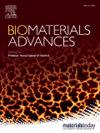Collagen/polyvinyl alcohol scaffolds combined with platelet-rich plasma to enhance anterior cruciate ligament repair
IF 5.5
2区 医学
Q2 MATERIALS SCIENCE, BIOMATERIALS
Materials Science & Engineering C-Materials for Biological Applications
Pub Date : 2024-12-29
DOI:10.1016/j.bioadv.2024.214164
引用次数: 0
Abstract
In anterior cruciate ligament (ACL) repair methods, the continuous enzymatic erosion of synovial fluid can impede healing and potentially lead to repair failure, as well as exacerbate articular cartilage wear, resulting in joint degeneration. Inspired by the blood clot during medial collateral ligament healing, we developed a composite scaffold comprising collagen (1 %, w/v) and polyvinyl alcohol (5 %, w/v) combined with platelet-rich plasma (PRP). The composite scaffold provides a protective barrier against synovial erosion for the ruptured ACL, while simultaneously facilitating tissue repair, thereby enhancing the efficacy of ACL repair techniques. The composite scaffold is primarily formed through hydrogen bonding between molecular chains and physical cross-linking of microcrystalline regions using a simple cyclic freeze-thaw method, resulting in improved mechanical properties and an extended degradation period. The maximum tensile fracture load of the composite scaffold reached 5.99 ± 0.30 N. The incorporation of PRP facilitates cell migration, proliferation, and blood vessel growth by enabling slow release of various growth factors. In vivo results demonstrate that this composite scaffold promotes rabbit hindlimb rupture ACL healing by stimulating fibroblast proliferation, collagen deposition, microvascular formation, and proprioceptor generation. Furthermore, it effectively reduces meniscus and cartilage wear while mitigating bone arthritis and joint degenerative diseases. Overall, our proposed composite scaffold holds great promise as a candidate for ACL healing.

胶原/聚乙烯醇支架联合富血小板血浆增强前交叉韧带修复。
在前交叉韧带(ACL)修复方法中,滑液的持续酶侵蚀会阻碍愈合并可能导致修复失败,并加剧关节软骨磨损,导致关节退变。受内侧副韧带愈合过程中的血凝块的启发,我们开发了一种由胶原蛋白(1%,w/v)和聚乙烯醇(5%,w/v)结合富血小板血浆(PRP)组成的复合支架。复合支架为断裂的前交叉韧带提供防止滑膜侵蚀的保护屏障,同时促进组织修复,从而提高前交叉韧带修复技术的疗效。复合支架主要采用简单的循环冻融法,通过分子链之间的氢键和微晶区域的物理交联形成,从而提高了材料的力学性能,延长了降解期。复合支架的最大拉伸断裂载荷达到5.99±0.30 n, PRP的掺入使多种生长因子缓释,促进细胞迁移、增殖和血管生长。体内实验结果表明,该复合支架通过刺激成纤维细胞增殖、胶原沉积、微血管形成和本体受体生成,促进兔后肢断裂前交叉韧带愈合。此外,它有效地减少半月板和软骨磨损,同时减轻骨关节炎和关节退行性疾病。总的来说,我们提出的复合支架作为前交叉韧带愈合的候选材料具有很大的前景。
本文章由计算机程序翻译,如有差异,请以英文原文为准。
求助全文
约1分钟内获得全文
求助全文
来源期刊
CiteScore
17.80
自引率
0.00%
发文量
501
审稿时长
27 days
期刊介绍:
Biomaterials Advances, previously known as Materials Science and Engineering: C-Materials for Biological Applications (P-ISSN: 0928-4931, E-ISSN: 1873-0191). Includes topics at the interface of the biomedical sciences and materials engineering. These topics include:
• Bioinspired and biomimetic materials for medical applications
• Materials of biological origin for medical applications
• Materials for "active" medical applications
• Self-assembling and self-healing materials for medical applications
• "Smart" (i.e., stimulus-response) materials for medical applications
• Ceramic, metallic, polymeric, and composite materials for medical applications
• Materials for in vivo sensing
• Materials for in vivo imaging
• Materials for delivery of pharmacologic agents and vaccines
• Novel approaches for characterizing and modeling materials for medical applications
Manuscripts on biological topics without a materials science component, or manuscripts on materials science without biological applications, will not be considered for publication in Materials Science and Engineering C. New submissions are first assessed for language, scope and originality (plagiarism check) and can be desk rejected before review if they need English language improvements, are out of scope or present excessive duplication with published sources.
Biomaterials Advances sits within Elsevier''s biomaterials science portfolio alongside Biomaterials, Materials Today Bio and Biomaterials and Biosystems. As part of the broader Materials Today family, Biomaterials Advances offers authors rigorous peer review, rapid decisions, and high visibility. We look forward to receiving your submissions!

 求助内容:
求助内容: 应助结果提醒方式:
应助结果提醒方式:


